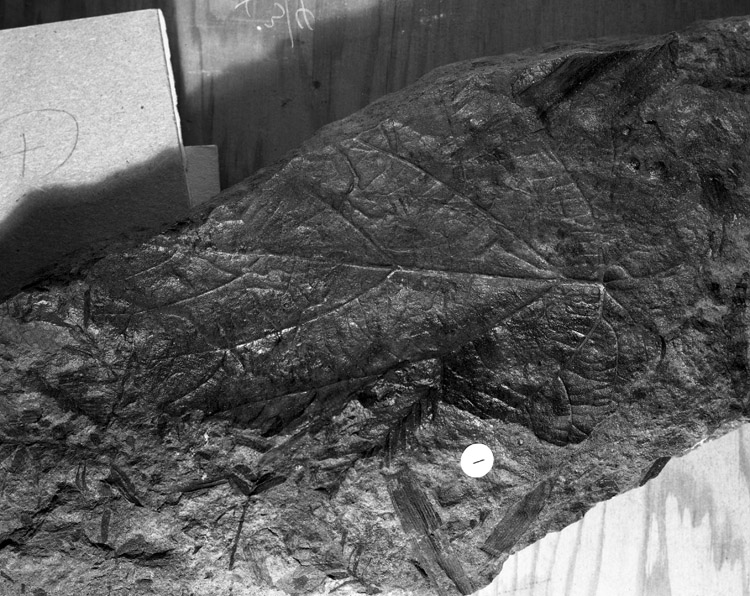Locality
Sagwon section along the western side of the Sagavanirktok River. A clay ironstone approximately 35 m stratigraphically below locality 11479 contained abundant angiosperm, fern, and conifer remains.
Description
Leaf: simple; symmetrical; shape ovate; apex missing; base cordate; margin crenate except at base where entire, teeth small (< 1.0 mm) irregular in size, apex rounded, sinus rounded; venation basal imperfect marginal actinodromous; primary midvein moderate, more or less straight; a-pectinals depart midvein suprabasally at an angle of 35-45°, may be initially recurved, uniformly curved; a-abmedials given off at an angle of approximately 45°, and curved, tending to be looped; b-pectinals arise at an angle of 90-105°, moderate, more or less uniformly curved with some abrupt changes of curvature at the departure points of the abmedial veins; b-abmedials given off on abmedial (basal) side at an angle of 70-90°, curved and forked and forming arches by joining the superadjacent b-abmedial or branch thereof at an obtuse angle; superior secondaries arising from the midvein at angles of approximately 45°, opposite or nearly so, curved but course somewhat irregular, may give off craspedodromous branches abmedially at 45°; tertiary veins percurrent, transverse, predominantly convex, joining both ad- and abmedial sides of secondaries at acute angles of 90°, concentric to the petiole junction with the lamina, may be forked; fourth order veins forming an orthogonal reticulum.
Remarks
Specimen USGS 11480.3 is apparently distorted rather than truly asymmetrical. These specimens are similar to Pterospermites whitei. In Ward's (1887) original description he stated that the leaves had rounded teeth (p. 94). Another species from the same locality P. minor Ward was described as having triangular instead of crenate teeth and Bell (1949) subsequently described dentate forms as P. whitei because he considered such margin characters to be of little importance in this group. Bell also considered P. auriculaecordatus (Hollick, 1936, p. 151; Plate 92, Figs. 1-5; Plate 93, Figs. 1, 2) to be forms of P. whitei. Wolfe (1966) described similar dentate forms from the Paleocene and Eocene Chickaloon Formation and synonymized P. auriculaecordatus (Hollick, 1936; Plate 92, Figs. 1-5) and Grewiopsis alaskana Hollick (1936, p. 149; Plate 85, Fig. 1) as Grewiopsis auriculaecordatus (Hollick) Wolfe. The clearly crenate margins of the leaves described here set them apart from those of Wolfe but they are undoubtedly part of a Paleocene complex encompassing both crenate and dentate forms. Wolfe (1966) notes the type of the genus Pterospermites Heer is a seed and not a leaf, therefore leaves should not be referred to the genus. This specimen should be compared to Corylites beringianus (Kryshtofovich) Golovneva.
